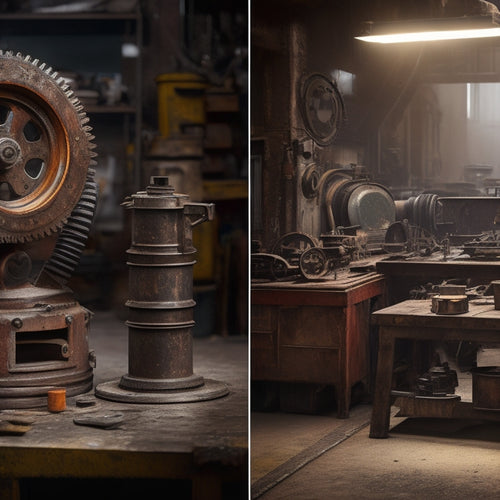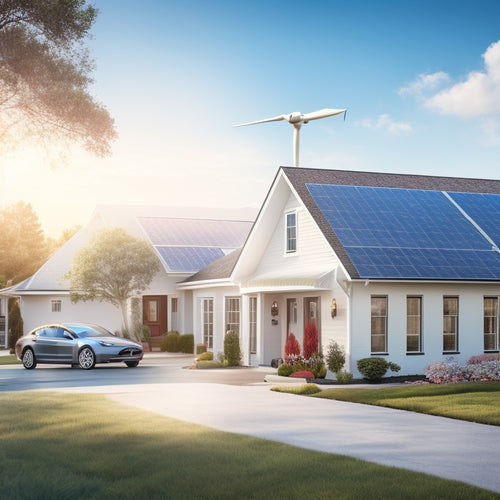
What's the Key to Lowering Your Energy Bills?
Share
By embracing renewable energy sources, such as solar, wind, and geothermal power, you can notably reduce your reliance on fossil fuels and lower your energy bills. Investing in green technologies not only reduces your carbon footprint but also provides long-term savings. Additionally, energy-efficient systems, such as smart thermostats and LED lighting, can minimize energy consumption. To maximize energy savings, crucial steps involve identifying areas of energy waste through energy audits and optimizing your energy usage. As you explore ways to reduce your energy costs, you'll discover more opportunities to harness the power of renewable energy and create a sustainable future for yourself.
Key Takeaways
• Investing in renewable energy sources, such as solar and wind power, can significantly reduce energy bills and carbon footprint.
• Energy-efficient systems, like smart thermostats and LED lighting, minimize energy consumption and lower energy costs.
• Proper insulation, window upgrades, and advanced HVAC systems can boost energy efficiency ratings and reduce energy waste.
• Embracing green technologies, such as energy storage systems, can optimize energy usage and provide a reliable backup power source during outages.
• Conducting energy audits and optimizing energy production can identify areas of energy waste and reduce energy expenditures.
Harnessing Power of Renewable Energy
By incorporating renewable energy sources, such as solar, wind, and geothermal power, into your home's energy mix, you can substantially reduce your reliance on fossil fuels and lower your energy bills.
This shift towards renewable energy not only benefits the environment but also makes financial sense.
Investing in green technologies is a smart move, as it can increase your property value and provide a strong potential for long-term savings.
Making green investments in renewable energy can pave the way to sustainable futures.
You'll be reducing your carbon footprint while also reducing your energy expenditures.
As the world evolves towards a more sustainable future, you'll be ahead of the curve, enjoying the benefits of reduced energy costs and a clearer conscience.
By embracing renewable energy, you're investing in a cleaner, healthier environment for generations to come.
Cutting Costs With Solar Panels
You can substantially reduce your energy bills by installing solar panels, which convert sunlight into electricity and can slash your reliance on the grid. Not only will you save money on your energy bills, but you'll also be doing your part for the environment. With solar panels, you can take advantage of solar incentives, such as tax credits and rebates, to offset the initial cost of installation.
| Solar Panel Benefits | Description |
|---|---|
| Renewable Energy Source | Convert sunlight into electricity |
| Energy Savings | Reduce energy bills by up to 50% |
| Environmental Benefits | Reduce carbon footprint and greenhouse gas emissions |
| Low Maintenance | Panels require minimal upkeep and cleaning |
| Increased Property Value | Boost your property's value with solar panels |
Benefits of Energy Storage Systems
Energy storage systems, which store excess energy generated by your solar panels or grid connection, can provide a reliable backup power source during outages and reduce your reliance on the grid.
With an energy storage system, you'll have a steady supply of power even when the grid goes down. This means you can keep your lights on, your fridge running, and your family safe during unexpected outages.
Another significant benefit of energy storage systems is their ability to optimize your energy usage.
By storing excess energy generated during the day, you can use it to power your home at night or during periods of high energy demand. This optimization can lead to significant cost savings and a reduced carbon footprint.
When selecting an energy storage system, consider the energy densities and cycle life of the batteries.
Energy densities refer to the amount of energy stored per unit of weight or volume, while cycle life indicates how many charge and discharge cycles the batteries can handle.
Reducing Reliance on Fossil Fuels
As you endeavor to reduce your reliance on fossil fuels, you'll want to explore alternative energy sources that are cleaner and more sustainable.
You'll find that renewable energy sources, such as solar and wind power, can substantially reduce your carbon footprint.
Renewable Energy Sources
By harnessing power from renewable sources, such as solar, wind, and hydroelectric energy, individuals can substantially reduce their reliance on fossil fuels and lower their carbon footprint.
This shift towards renewable energy sources is vital in the fight against climate change.
As you explore ways to reduce your energy bills, understanding the role of energy policy in promoting the adoption of green infrastructure is imperative.
Governments and organizations are implementing policies to incentivize the development of renewable energy sources, making it more accessible and affordable for individuals and businesses.
By investing in renewable energy, you're not only reducing your energy bills but also contributing to a cleaner, more sustainable future.
With the cost of renewable energy decreasing, it's becoming a more viable option for those looking to reduce their reliance on fossil fuels.
As you consider your energy options, remember that every small step counts, and switching to renewable energy sources can have a significant impact on reducing your carbon footprint.
Energy Efficient Systems
Switching to energy-efficient systems is a crucial step in reducing your reliance on fossil fuels, and you can start by upgrading to smart thermostats and LED lighting.
These simple changes can make a substantial impact on your energy consumption. Smart thermostats, for instance, can learn your schedule and preferences to optimize your heating and cooling usage. LED lighting, on the other hand, uses noticeably less energy than traditional incandescent bulbs.
As you continue to upgrade your home, consider integrating more energy-efficient systems, such as energy-recovery ventilation systems and solar water heaters. These systems can be especially beneficial in green buildings and smart homes, where energy efficiency is a top priority.
By incorporating these systems, you'll not only reduce your energy bills but also minimize your carbon footprint. By taking these steps, you'll be well on your way to creating a more sustainable and energy-efficient living space.
Start making the switch today and reap the benefits of a more eco-friendly home.
Boosting Energy Efficiency Ratings
You can substantially boost your home's energy efficiency ratings by focusing on key areas such as insulation, window upgrades, and advanced HVAC systems.
By conducting an energy audit, you'll identify areas where energy is being wasted and prioritize improvements.
Start with home insulation, as it's vital in reducing heat loss and gain. Verify that your attic, walls, and floors are well-insulated to prevent energy escape.
Consider upgrading to energy-efficient windows, which can notably reduce heat transfer and minimize energy loss.
Advanced HVAC systems, such as heat pumps or radiant floor heating, can also improve your home's energy efficiency.
The Role of Wind Turbines Today
As you explore ways to lower your energy bills, you'll likely consider the role of wind turbines in generating renewable energy.
You'll want to understand how turbine blades are designed to maximize energy capture, and how wind farms can optimize their efficiency to reduce your reliance on non-renewable sources.
Turbine Blades Design
Wind turbine designers carefully optimize blade shapes and angles to maximize energy capture, since even slight adjustments can substantially impact power output.
You might be surprised to learn that subtle tweaks to the aerodynamic shape of a turbine blade can markedly boost power generation.
By applying airfoil optimization techniques, designers can refine the curved surface of the blade, allowing it to slice through the air more efficiently. This, in turn, enables the turbine to harness more energy from the wind.
As you explore the intricacies of turbine design, you'll discover that every detail counts. The precise angle of attack, the subtle curve of the blade's trailing edge, and even the material used to construct the blade all play a critical role in determining its performance.
Wind Farm Efficiency
Today's wind farms rely on sophisticated turbine layouts and strategic placement to maximize energy production, making them a fundamental component in the quest to lower your energy bills.
As you explore ways to reduce your energy costs, understanding the role of wind turbines is essential. Wind farms operate at their best when turbines are positioned to take advantage of ideal wind speeds.
This is because wind speed plays a significant role in energy production, with even slight increases in speed resulting in substantial boosts in power output.
To guarantee maximum efficiency, wind farm operators prioritize turbine maintenance, performing regular checks to detect and address any issues promptly.
This proactive approach helps to:
- Minimize downtime and reduce repair costs
- Optimize energy production and lower your bills
- Extend the lifespan of turbines and reduce waste
- Improve overall wind farm reliability and performance
Renewable Energy Source
You're increasingly relying on renewable energy sources, and wind turbines play a vital role in this shift, generating clean electricity and reducing your reliance on fossil fuels. As you adopt more sustainable habits, you're contributing to a broader evolution towards a greener future.
In fact, wind power has become an integral part of many countries' energy policy, with governments setting ambitious targets for renewable energy production.
Today, wind turbines are more efficient than ever, with advancements in technology allowing them to harness energy at lower wind speeds.
This has made it possible to install turbines in a wider range of locations, further increasing their potential to reduce greenhouse gas emissions.
Additionally, the integration of wind power into the grid has become more seamless, ensuring a reliable supply of electricity.
As you invest in green infrastructure, you're not only reducing your energy bills but also contributing to a cleaner environment.
Geothermal Energy Cost Savings
By investing in a geothermal energy system, you can substantially reduce your energy bills, with studies showing that homeowners can save up to 70% on their heating and cooling costs.
This is because geothermal energy harnesses the natural heat from the Earth's crust, providing a reliable and consistent source of energy. One of the most significant advantages of geothermal energy is its ability to provide both heating and cooling, making it an ideal solution for year-round energy savings.
Higher efficiency: Geothermal systems can achieve efficiencies of 300-400%, compared to traditional HVAC systems which typically have efficiencies of 90-95%.
Lower maintenance: Geothermal systems have fewer moving parts and are less prone to breakdowns, reducing the need for costly repairs.
Longer system lifespan: Geothermal systems can last for 20-30 years or more, compared to traditional HVAC systems which typically last for 10-15 years.
Government incentives: Many governments offer incentives and tax credits for homeowners who invest in geothermal energy systems.
Biomass Energy for Businesses
As you consider biomass energy for your business, you'll want to examine the cost savings it can bring to your operation.
A thorough analysis will help you determine the financial benefits of switching to biomass energy and how it can reduce your energy bills.
Additionally, you'll need to assess the carbon emission reduction potential and understand the system implementation process to ensure a seamless transition.
Cost Savings Analysis
Conducting a thorough cost savings analysis is essential for businesses considering a switch to biomass energy, as it helps identify potential financial benefits and justifies the investment in this renewable energy source. You want to verify that shifting to biomass energy will indeed lead to significant cost savings for your business.
An in-depth cost savings analysis involves conducting energy audits to pinpoint areas of inefficiency and opportunities for improvement.
This analysis also provides financial projections, helping you anticipate the return on investment (ROI) of shifting to biomass energy.
By doing so, you'll be able to:
- Identify potential energy savings
- Determine the payback period for your investment
- Compare the costs and benefits of different biomass energy solutions
- Develop a clear business case for investing in biomass energy
Carbon Emission Reduction
You can substantially reduce your company's carbon footprint by switching to biomass energy, which not only helps the environment but also enhances your brand reputation.
As a business owner, you're likely aware of the importance of adopting a sustainable lifestyle. By shifting to biomass energy, you'll dramatically decrease your reliance on fossil fuels, resulting in a notable reduction in greenhouse gas emissions.
This, in turn, can lead to cost savings through carbon pricing initiatives. With biomass energy, you'll be producing clean energy while reducing your company's carbon emissions.
Additionally, you'll be contributing to a cleaner environment, which can lead to increased customer loyalty and brand recognition. By embracing biomass energy, you'll be taking a major step towards a sustainable future, setting your business apart as an environmentally responsible leader in your industry.
System Implementation Process
Implementing a biomass energy system for your business involves a thorough assessment of your energy needs and infrastructure to determine the most suitable technology and configuration. This crucial step ensures that your system is tailored to your business's unique requirements, maximizing energy efficiency and cost savings.
Once you've identified the optimal system, it's time to outline a Project Timeline. This roadmap will guide the installation process, ensuring a smooth transition to renewable energy.
System design and engineering: Define the system's technical specifications and layout.
Equipment procurement: Source high-quality biomass energy equipment and components.
System installation: Install the biomass energy system, ensuring compliance with safety standards and regulations.
System Testing: Perform thorough testing to ensure the system operates efficiently and safely.
Hydroelectric Power for Industry
Hydroelectric power plants, which have been harnessed for over a century, now generate approximately 16% of the world's electricity, making them an attractive option for industries seeking to reduce their reliance on fossil fuels.
As you consider hydroelectric power for your industry, key understanding of the infrastructure involved is vital. Hydroelectric infrastructure typically consists of a dam, water turbines, and a power generation unit.
The dam creates a reservoir, and the water turbines convert the energy of the falling water into mechanical energy. This mechanical energy is then converted into electrical energy through the power generation unit.
Water turbines are a vital component of hydroelectric infrastructure, as they determine the efficiency of the power plant. You'll want to choose turbines that optimize energy production while minimizing environmental impact.
Investing in a Greener Tomorrow
By adopting eco-friendly practices and renewable energy sources, industries can substantially reduce their carbon footprint and create a sustainable future for generations to come.
As you invest in a greener tomorrow, you're not only contributing to a healthier environment, but also paving the way for long-term cost savings.
Green investments are no longer a niche concept, but a necessary step towards a sustainable future.
By diversifying your energy portfolio with renewable sources, you can:
- Reduce reliance on fossil fuels and lower energy costs
- Increase energy independence and reduce price volatility
- Improve brand reputation and appeal to environmentally-conscious consumers
- Future-proof your business against evolving environmental regulations
Frequently Asked Questions
How Do I Know if My Home Is Suitable for Renewable Energy?
To determine if your home is suitable for renewable energy, you'll need a thorough Home Assessment, including an Energy Audit, to identify areas of energy inefficiency and potential for solar, wind, or geothermal integration.
Can I Install Energy-Efficient Appliances on a Tight Budget?
You can install energy-efficient appliances on a tight budget by prioritizing budget-friendly upgrades, focusing on energy priorities like swapping incandescent bulbs for LEDs and replacing old appliances with Energy Star-rated ones.
Are Energy Storage Systems Compatible With Existing Infrastructure?
As you explore energy storage systems, you'll find they're compatible with existing infrastructure, thanks to advancements in grid integration, allowing for seamless upgrades, and minimizing the need for costly infrastructure upgrades.
What Are the Benefits of Retrofitting Older Buildings for Energy Efficiency?
When you retrofit older buildings for energy efficiency, you'll reap benefits like reduced energy consumption and costs. Start with building insulation upgrades and conduct energy audits to identify areas for improvement, then prioritize changes for maximum impact.
How Do Local Energy Policies Impact Residential Energy Costs?
As you navigate local energy policies, you'll find that policy incentives and energy zoning regulations substantially impact your residential energy costs, offering opportunities for savings and a more sustainable future.
Related Posts
-

Why Higher Upfront Costs Are Worth It
You pay a premium for high-quality, energy-efficient products, but they're worth it. With durability testing ensuring...
-

Why Electric Motorcycles Fail at Long-Distance Touring
You're likely familiar with the excitement of hitting the open road on an electric motorcycle, but you're also smart ...
-

Why Homeowners Are Embracing DIY Energy Independence
By taking control of your energy needs, you're breaking free from the uncertainty of utility bills and embracing a se...


